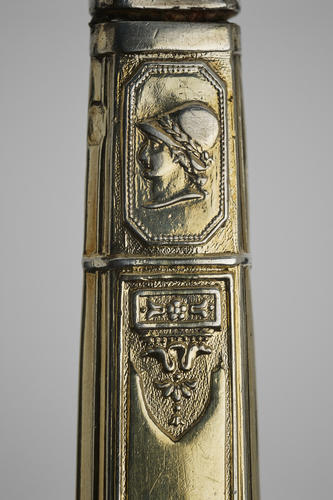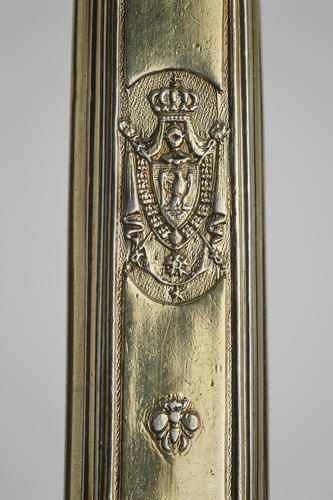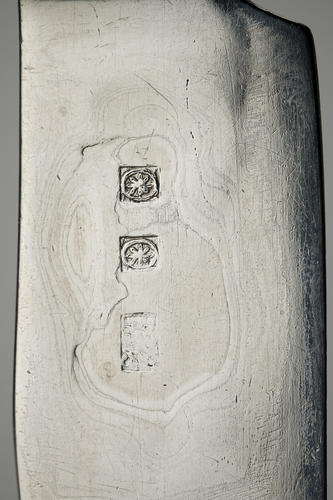Knife 1804-09
Silver gilt, with steel blade | 23.2 cm (Length) (whole object) | RCIN 48460

Martin Guillaume Biennais (1764–1843)
Knife 1804-09

Martin Guillaume Biennais (1764–1843)
Knife 1804-09

Martin Guillaume Biennais (1764–1843)
Knife 1804-09

Martin Guillaume Biennais (1764–1843)
Knife 1804-09

Martin Guillaume Biennais (1764–1843)
Knife 1804-09





-
A table knife with a silver-gilt handle and steel blade (slightly curved and pointed); stamped with a helmeted profile of Minerva, palmette and husk, bees, the Imperial arms of Napoleon and N in a roundel within a laurel wreath (on both sides).
The design of is typical of the knives supplied by Biennais to Napoleon after his coronation, using the emblems associated with the Emperor, including his personal symbol of a bee, as well as his arms and cipher. Occasionally the profile of Minerva would be replaced by Napoleon himself.
Martin Guillaume Biennais (1764–1843) was originally a cabinet maker and tabletier (dealer and maker of small objects) with established premises at 283 rue St Honoré by 1789 'Au Singe violet' (at the sign of the purple monkey). With the ending of guild restrictions following the passing of the Chapelier laws in 1791 he diversified his business to include the production of silver and gilt items. He supplied Napoleon Bonaparte and his family from as early as 1798 including, in 1804, the Emperor's crown and sceptre for his coronations in Paris and Milan.
Struck on handle with illegible marks; blade stamped twice with a spoked-wheel symbol and another (illegible) mark.Provenance
There have been several versions of Bonaparte's escape and the capture of his carriages and belongings after the Battle of Waterloo. What is certain is that the Emperor left the battlefield on the evening of 18 June 1815 and was in Paris in the early hours of 21 June 1815. On the following day he abdicated in favour of his son, the King of Rome; this was unacceptable and a provisional government was appointed.
Of the various versions of the capture of Napoleon's carriages the most reliable source is found in a statement provided for legal proceedings held in 1826 to resolve the ownership of items pillaged at the end of the battle. At the head of the Prussian advance on the fleeing French army was a battalion of fusiliers of the 15th Regiment of Infantry commanded by Major Eugen von Keller. The battalion was close to Napoleon's former headquarters of Le Caillou, close to Genappe, when the soldiers became aware of a carriage in difficulty. Von Keller recognised the carriage as belonging to the Emperor; he claimed it as his own.
Further on, towards Charleroi and close to Quatre Bras, the Prussian advance came upon the remainder of the French baggage train. Among the vehicles in this train was the 'Berlin' landau used by Napoleon for light service during his campaigns. It was taken by Lieutenant Lindenhof from Von Keller´s regiment and, so, Von Keller came to be in possession of two Imperial carriages. As a Prussian officer, his right to booty was dependent on the permission of his superior officers; in order to secure the first carriage he offered the pillaged 'Berlin' landau to Field Marshal Prince Gebhard von Blücher, retaining the first 'dormeuse' carriage for himself. The landau was presented to the Musée National de Châteaux de Malmaison by the descendants of Marshal Blücher in 1975.
Von Keller sold the carriage to the showman William Bullock who put in on display in his 'Museum of Curiosities' at the Egyptian Hall in Piccadilly in January 1816. He then toured it around the West Country; en route he showed it to the Royal Family at Windsor Castle. The carriage was acquired by Madame Tussaud in 1842, remaining in the Tussaud collection until it was destroyed on 18 March 1925 when a disastrous fire swept through the museum.
An extract from a letter to Sir John Bland-Sutton from Maud Gurney of Earlham Hall, Norwich written c.1909 recounts ‘It is one of the knives taken out of Napoleon’s carriage at Waterloo after his flight. The whole set were sold to my great-grandfather, Sir Thomas Cullum, just after Waterloo, and they are now owned by my uncle, Gery Milner Gibson Cullum, who gave me this one. My uncle also has a part of his silver-gilt writing set, the rest of which was bought by Madame Tussaud.’
It would, therefore, appear that Sir Thomas Cullum acquired the set of knives around the time of the sale of the carriage to Madam Tussaud. It is reasonable to suppose that Mrs. Gurney presented the knife to Sir John-Bland-Sutton who became President of the Royal Society of Medicine. Sir Alfred Webb Johnson, Queen Mary's surgeon between 1936 and 1953, presented the knife to Queen Mary at Christmas 1939; he may well have acquired the knife from Sir Thomas Bland-Sutton's estate after his death in 1936. -
Creator(s)
(silversmith)(nationality)Acquirer(s)
-
Medium and techniques
Silver gilt, with steel blade
Measurements
23.2 cm (Length) (whole object)
81.6 g (Weight) (whole object)
Category
Place of Production
Paris [Île-de-France]









